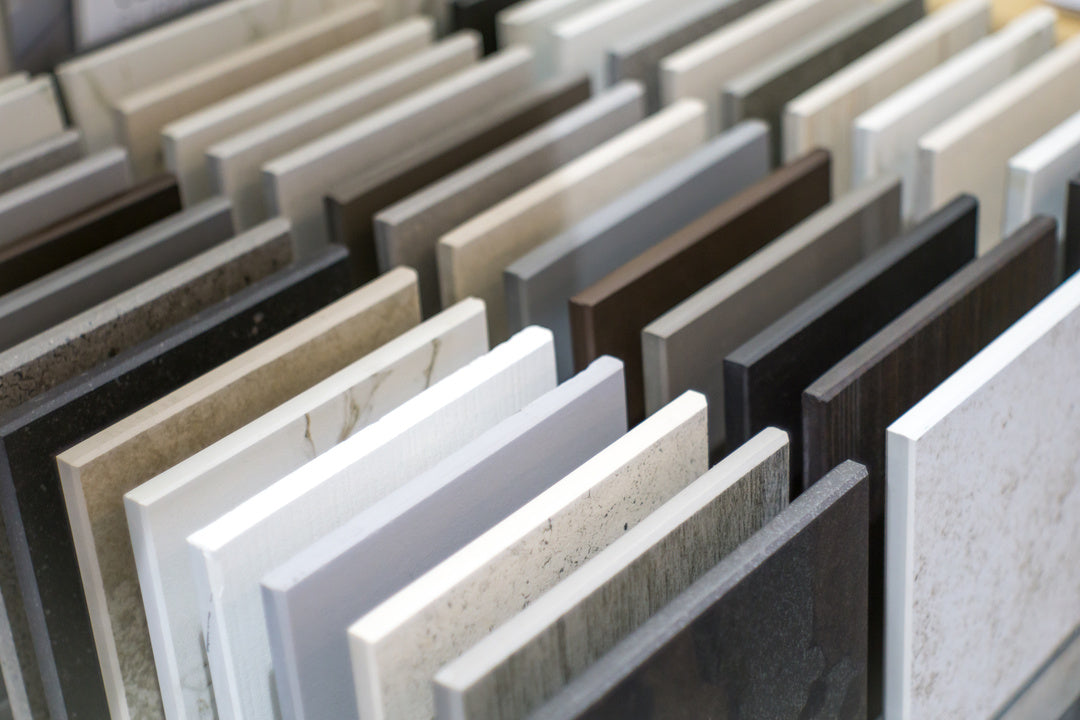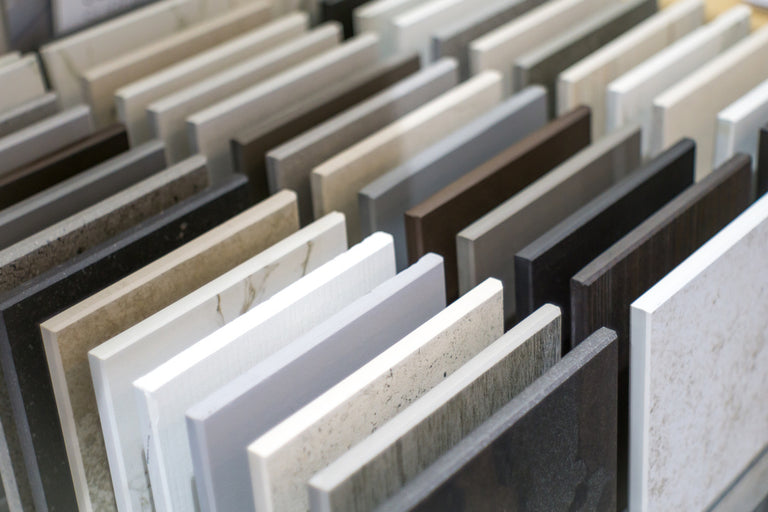INTRODUCTION
Natural stone is sourced from all over the world and comes in a bewildering array of colors and types. We’ve developed this guide to help you determine which stone is best for you—this will help to ensure that you are happy with your selection for many years to come.
There are two primary considerations when selecting stone. The first is the aesthetics, or the color and “patterning” of the stone. This includes flecks, veins, or bands that might be present. The second is durability, or how well the stone will perform in the intended application. A balance of these two considerations will help you select a stone that will remain beautiful and functional for a lifetime.
Our primary purpose with this guide is to give you an overview of the types of stones that are available, the possible color ranges, and the durability and performance of the stones in various applications. This guide is therefore intended to provide you with a knowledge base that will ensure you have the right information to make informed decisions, but we always recommend working with an experienced stone provider during the stone selection process. Butdon’t worry, the process isn’t difficult or daunting when you have the right information, so let's get started.
Stone Naming In The United States
Unfortunately, there are no regulations governing the official naming of stones in the United States. This applies to both the type of stone (like granite, marble, travertine, etc.) and specific stone colors (like “Pearl” and “Ivory”). Two identical stones may have very different names, and conversely two stones that are named the same may be very different. This can create quite a bit of confusion, but we’ll start by discussing the most common stone types below. A knowledgeable stone supplier in your area can help you determine which type of stone you’re actually considering when looking at specific stones.
TYPES OF STONE
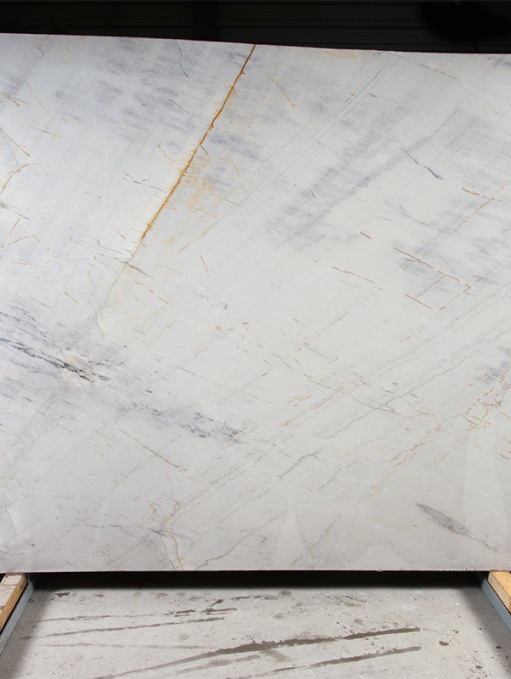
Quartzite
Quartzite has become more popular in recent years. It is a naturally occurring stone, not to be confused with manufactured or “engineered” quartz surfacing. Quartzite began its life as quartz (silica) sand, and through geologic heating and pressure was transformed into a durable mosaic of quartz crystals. This transformation is called “metamorphosis”; consequently, Quartzite is termed a “metamorphic” stone. Quartzite is a very hard and durable material, is resistant to staining and abrasion, and can usually take a very high polish. The color range is typically in various shades of white to grey, but other colors such as beige, pink and blue may be found. Since the initial formation of quartzite typically involves sedimentary processes, the presence of veins, reminiscent of marble, is common. In some ways Quartzite can be thought of as a hybrid between granite and marble, generally having the hardness of granite (even better in many cases), but the appearance of marble. If you like the look of marble, but want the durability of granite, quartzite might be the right choice for you.
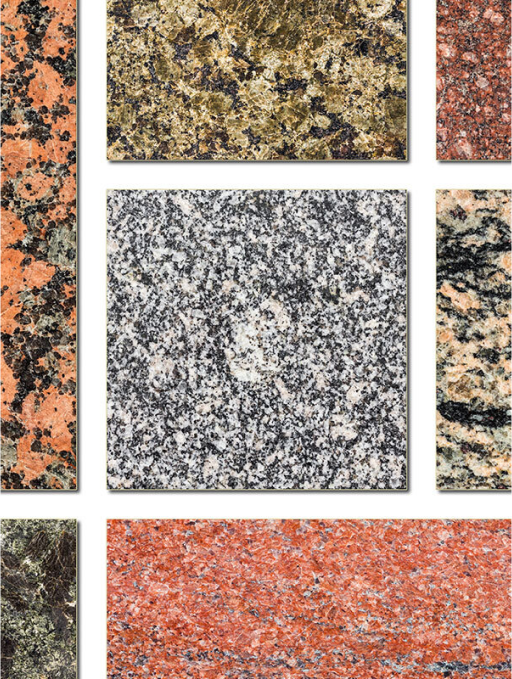
Granite
Granite has been used for thousands of years, prized for its beauty and hardness. This traditional stone is the most common material used in solid slab countertops. Granite is an “igneous “rock formed from the slow crystallization of magma deep below Earth's surface, and is one of the hardest stones commonly used commercially. It is very resistant to stains and scratches, and is especially common in kitchens and baths due to its durability and wide range of colors. Granites often have a lot of patterning and may be composed of many different colors creating a mosaic effect. Although some granites may have veins, most are mottled or flecked, helping to distinguish it from marble, which is usually veined. Often, granite contains highly contrasting colors, adding to the beauty and distinction of particular stones. Some of these colors may also be reflective, giving the stone a pleasing sparkling effect. Granite colors range from the blackest black to a white background with small flecks, and almost any color combination in-between. Browns, pinks, reds, and even greens and blues are available. The wide variety of colors, along with its durability, makes granite a favorite.
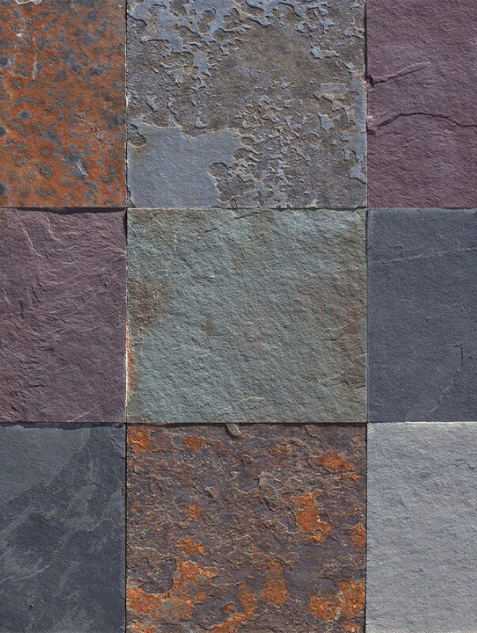
Slate
Slate is a fine-grained metamorphic rock. Slate began its life as a sedimentary material composed of clay or volcanic ash. It then underwent relatively low-temperature and pressure metamorphosis to form the stone we see today. Slate often “cleaves” or splits readily into thin slabs. The unworked surfaces of these cleavage plains are typically left intact and give slate its characteristic rough “organic” appearance.
Historically, slate has been used extensively as a roofing material due to the ease in creating thin durable tiles or “slates”. Similarly, slate is very common as a flooring material, often used outdoors as very natural-looking stepping stones or pavers. Slate as countertop material is not frequently seen, as it is a very porous stone with uneven surfaces. Slate is much more commonly found as flooring and as a wall material. Large slate slabs are not common due to the relatively poor strength properties of the stone.
Slate varies tremendously in quality, with some stones being particularly fragile and prone to “spalling” where surface chips detach. In outdoor areas, this is not problematic and usually does not markedly detract from the appearance of the stone. Many slates have a very rough surface which can be an asset if used as a flooring material in high-slip areas, such as outdoor patios, etc. Slate may not perform very well in high traffic areas, though, where repeated heavy use may cause unacceptable wear on the stone. This is especially true in cases where heavy objects will be rolled across the surface.
Slate cannot be polished to a high shine; however, a surface sealer can be used which can provide a high-gloss or semi-gloss surface. Be aware, however, that with surface sealers, the actual exposed surface is not the stone, but the sealer itself, and will be subject to the limitations of the sealer (see more about stone sealers in our Stone Sealing and Care Guide). Slate has a relatively narrow color range, with the vast majority of slates being various shades of gray. Slate can also be found in grayish tan versions, as well as rusty reds. Some slates are multicolored within this color range, as a function of how the stone splits along its cleavage lines. Slate can also have a very wide range of color and surface texture from piece-to-piece. Slate can be very economical depending in the specific quality and rarity of the stone, and is known for its ability to add a natural “zen” look to living areas.
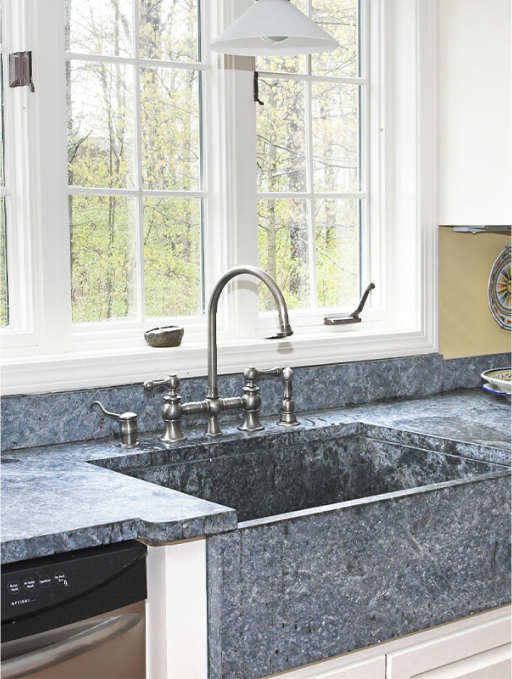
Soapstone
Soapstone is a metamorphic rock composed principally of the mineral talc in varying amounts. Talc itself is an extremely soft mineral (think baby powder) but through high pressure and heat beneath the earth’s surface, talc is transformed into soapstone. Its name comes from the very silky feel of the stone, similar to a bar of soapand gives the impression of a soft surface, although the soapstone used for countertops, sinks, etc. is actually quite hard. Of all the stones discussed, it is the most non-porous.
Soapstone also has very unique heating properties, and for that reason may be used with heaters, or used as an actual cooking surface. Soapstone can be found in many applications including flooring, but it is probably most commonly found as a countertop material. Sinks can even be manufactured from soapstone identical to that of the countertop, making for a unique, cohesive aesthetic. The soapstone color palate is relatively narrow compared to many other stones, with various shades of grey, green, and black being the most common. Note that the “color” of the soapstone will differ considerably depending on the surface treatment (see more under “Sealing and Care of Natural Stones”).
MARBLE, TRAVERTINE, LIMESTONE & ONYX
Marble, Travertine, Limestone, and Onyx are related stones, so it’s helpful to discuss them as a group. We’ll call this the “limestone” group. Unfortunately, the close relationship of the stones in this group causes confusion, and there’s a great deal of misinformation regarding the naming and characteristics of these stones. Stones in the limestone group are composed primarily of calcite (calcium carbonate, CaCO3). This mineral is easily attacked by acids (think how vinegar reacts with baking soda, sodium bicarbonate). Although not nearly as fast as this reaction, acids will eventually dissolve calcite-based materials. The limestone group stones are also susceptible to staining. This makes it important to understand how these stones will perform in various applications.
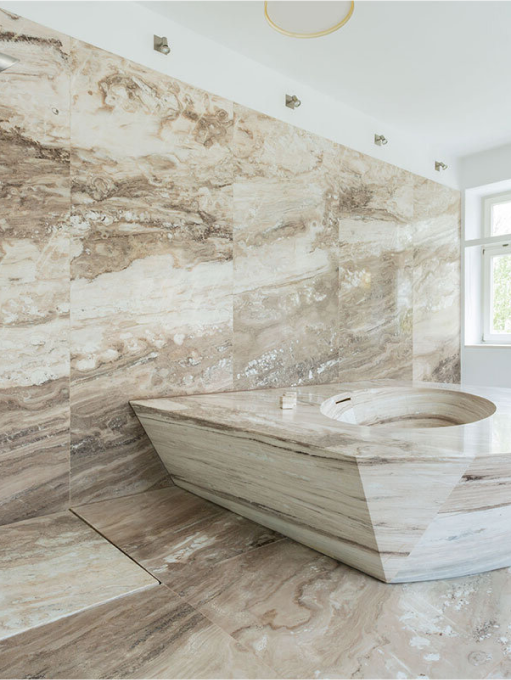
Marble
Of the three stones in the limestone group, marble is the only one that is a metamorphic rock (metamorphosed limestone). But in the stone industry, the term “marble” may also be used for unmetamorphosed limestone. It is formed when limestone is subjected to heat and pressure. This causes the material to become denser and harder.
Because marble began life as a sedimentary stone, veins or striations are commonly present. Many colors are also available due to various impurities being present in the stone. Light colored marbles may also have a translucent quality. Marble has been prized for its beauty throughout history and most high-quality marbles will take a high polish. High-polished marbles typically used for countertops are prone to acid attack and staining, as discussed above. Staining can be especially problematic on light colored stones. Given these properties, marble may not be the best choice for kitchen countertops or bathroom sinks where staining can be a problem. Proper sealing of marble can help with these issues, but marble will not generally perform as well as quartzite or granite in these applications.
Marble flooring is common but will scratch if a high-polish finish is used. Honed finished flooring can offer a more durable surface while still retaining much of the beauty of the stone. (See more about finishes in our “Stone Finish Selection Guide”) For decorative areas where durability is not a concern, marble is unsurpassed. Its workability and beauty have made it the stone of choice for many sculptors, and its translucent qualities make it a favorite for back-lit decorations, etc. Marble is available in a huge range of colors and patterns ranging from pure white to pure black and almost everything in-between. Greys and various browns are common, but unique colors including rich greens can be found. Some marbles are composed of highly contrasting colors, as if different stones were cemented together. This mosaic effect can be especially beautiful, making color combinations and pattern options almost endless.
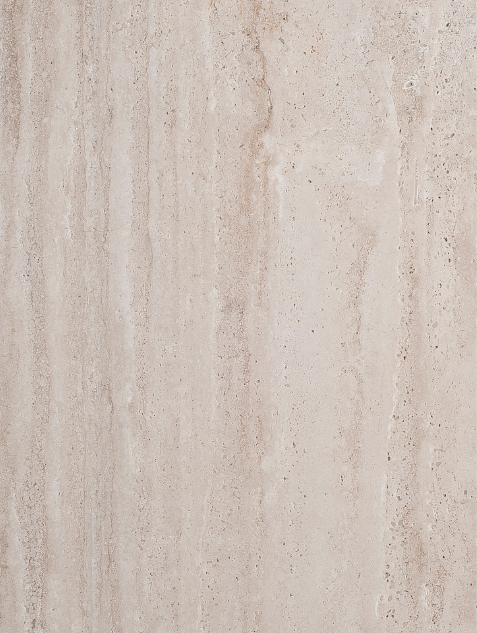
Travertine
Travertine is formed by the precipitation of calcium carbonate usually around mineral springs, especially hot springs or caves (think stalactites and stalagmites). It is considered a sedimentary rock, unlike marble which is a metamorphic rock. Many travertines contain voids in the surface, even if the stone is polished. These may be “filled” during manufacturing with a synthetic material to create a smooth surface, or left as-is. Often the filled areas are imperceptible, looking like a normal part of the variation of the stone coloring. Unless the effect is desirable, travertines containing holes and fissures will become imbedded with dirt and debris which can be problematic for flooring and countertops.
Travertines can be polished, and depending on the quality of the stone, can take a relatively high polish. Typically, though, travertines cannot be polished to the full gloss common with quartzite, granite, or marble. Travertine is very common as flooring tiles, and pavers, and can be quite economical, especially in the more common colors. Due to the potential for staining and acid attack, travertine is less desirable for kitchen and bath countertops, but can successfully be applied to these areas if it is property sealed and cared for. Travertine tiles are much more common than solid travertine slab surfaces for these applications. Travertines typically have a narrower color range than some of the other stones, usually in “earth” tones of tan to light chocolate brown, along with various shades of gray. Surface patterning is common, but some stones are nearly pattern-free. The presence of veins is less common with travertine than with marble. Travertine is often quite economical and provides a natural organic look to any space, making it a very commonly used stone.
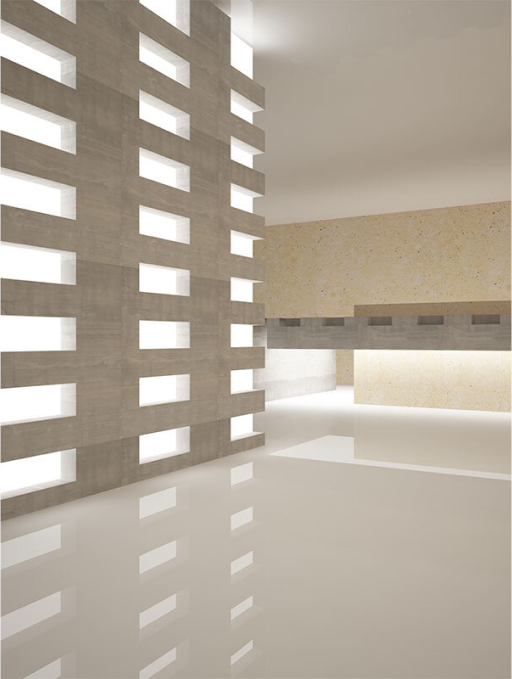
Limestone
Although similar in composition to travertine, limestone is often composed from the skeletal fragments of marine organisms in a sedimentary process. Subsequent heat and pressure help to create a relatively hard and durable stone, which is generally harder than travertine.
Limestone has been a favorite material for architectural purposes throughout history due to its balance between workability and durability. Many of the buildings from history are constructed from limestone, and it is still used as a facing material for many buildings today. Limestone flooring is very common, as is its use in bathrooms and showers. And many decorative stone items, such as columns, mantelpieces, banisters, etc. are made of limestone. Limestone can be polished but will typically not take as high a polish as will quartzite, granite, or marble.
Limestones come in a color range similar to travertines, but the patterning is often less distinct. Very light neutral colors are most common consisting of various beiges and greys. Pinkish hues are also quite common with limestone. As with travertine, limestone can be quite economical and can provide a durable and attractive surface in the right applications.
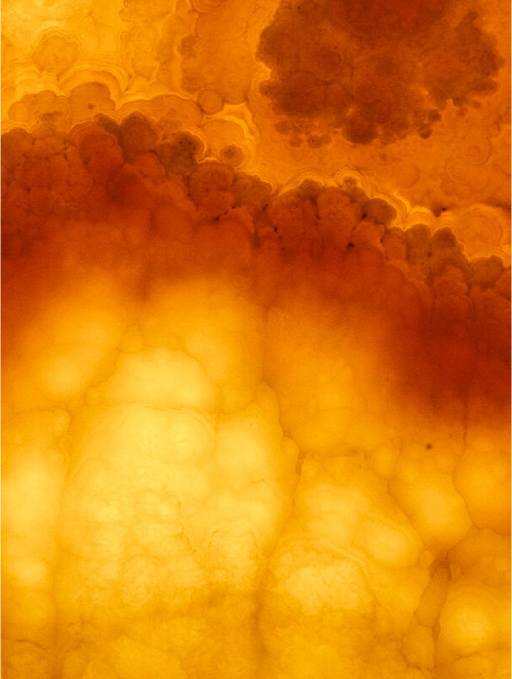
Onyx
The name “onyx” can be especially confusing because Onyx for architectural surfaces may also be known as Onyx Marble, Egyptian Alabaster, Cave Onyx, and Mexican Onyx. The onyx used for surfaces should not be confused for the semi-precious stone of the same name often used in jewelry, which is a type of chalcedony. Onyx is formed in a manner very similar to travertine and has a similar composition. In a sense, onyx can be thought of as a superb form of travertine butnfortunately often has a price to go along with its beauty and rarity.
Where travertine has a porous surface often with pits or voids, onyx is smooth and relatively non-porous. It is known for its ability to take a high polish, and especially for its translucent qualities which can be quite remarkable. For these reason, (along with its high cost) onyx is often used for purely decorative purposes, sometimes back-lit for added emphasis. Onyx is often heavily banded and may have strongly contrasting colors. Colors range from very light, almost white, to tan and deep brown. Light greens with bands of white and purple can also be found, so if you’re looking to make a strong statement, onyx might be the right stone for you!
SELECTING STONE FROM SAMPLES
A knowledgeable stone provider is an excellent resource to help you select a stone that will be both beautiful and durable for your application. One option is to start with a particular color in mind, then look at the different stones available in that color, comparing the durability and costs of stones meeting your color restrictions. Alternatively, you may select a stone type the is most appropriate for your application, then select an attractive color. No matter which option you choose, a common way to start this process is to look at stone samples. These may be in the form of tiles on display in a showroom, or they may be small sections of solid slabs that act as representative samples of the stone.
While selecting stones from showroom samples may be a great way to get started, keep in mind that making a final selection from a sample can be problematic.
For patterned stones, you may not be able to get a true impression of what the stone looks like in its entirety. For instance, the marble slab shown below is highly veined. It’s simply not possible to capture the overall impression of the stone with a small sample. The cutout view shows how a small sample might look, and what impression this gives compared to the slab itself. For this reason, we always recommend working with your stone provider to view the entire slab for a full and complete picture prior to final selection.
TAG SIMPLECOAT®
Join our online community



